Navigating MLA Format Citation Styles: A Roadmap to Accurate Citations
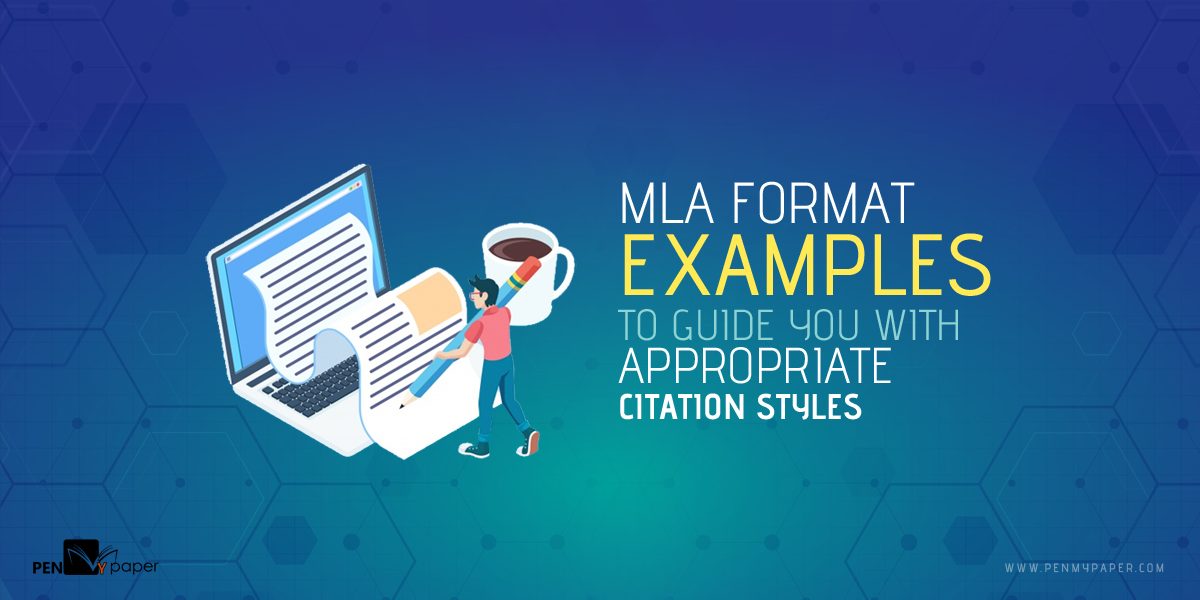
Quick Navigation
In the world of academia and research, accurate citation is a fundamental skill that distinguishes scholarly work from mere opinion. The Modern Language Association (MLA) format is one of the most widely used citation styles, providing a standardized method for citing sources and ensuring proper attribution. This comprehensive guide will delve into the intricacies of MLA citation, specifically focusing on in-text citations and the Works Cited page. By the end, you will possess the knowledge and confidence to navigate these elements flawlessly. For further assistance with your assignment, give us a nudge by stating “Write a paper for me” and our expert writers will take on the task for you.
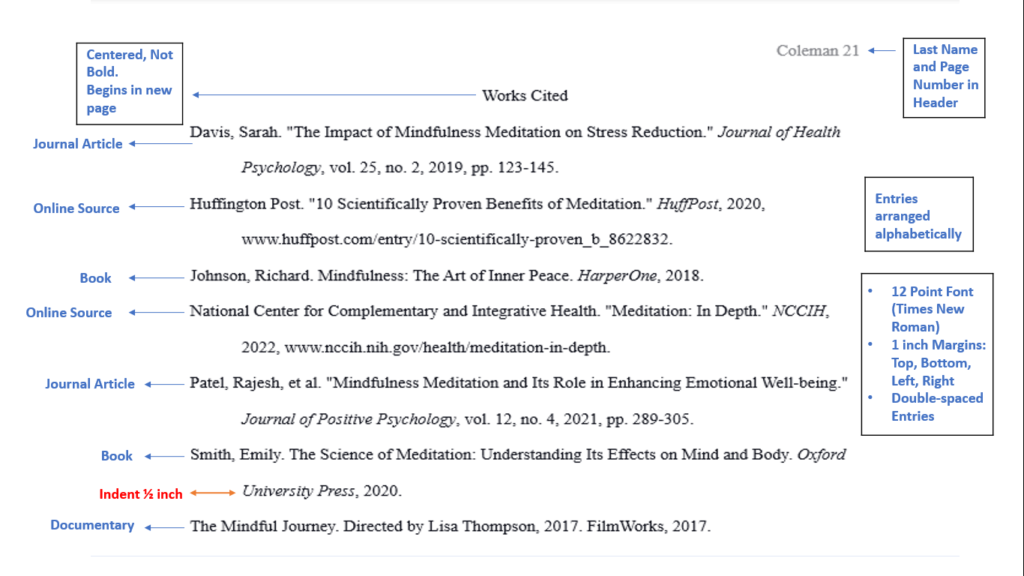
Understanding In-Text and Parenthetical Citations
In-text Citations in MLA
In-text citations in MLA style are used to acknowledge and provide brief information about the sources you have used within the body of your paper. These citations typically include the author’s last name and the page number(s) from which the information is taken. Here’s how to format in-text citations in MLA:
For a direct quotation:
Place the author’s last name and the page number(s) in parentheses immediately after the quotation. If the author’s name is mentioned in the sentence, only include the page number(s) in parentheses. Here’s an example:
“The future belongs to those who believe in the beauty of their dreams” (Smith 45).
According to Smith, “The future belongs to those who believe in the beauty of their dreams” (45).
For a paraphrase or summary:
Place the author’s last name and the page number(s) in parentheses after the paraphrased or summarized information. If the author’s name is mentioned in the sentence, only include the page number(s) in parentheses. Here’s an example:
Climate change is a global crisis that requires immediate attention (Johnson 25-27).
Johnson argues that climate change is a global crisis that requires immediate attention (25-27).
For a source with no page numbers:
If the source you are citing does not have page numbers (e.g., a website), you can use other identifying information, such as the author’s last name or a shortened title. If there is no author, use a shortened version of the title instead. Here’s an example:
According to the National Wildlife Federation (“Climate Change Impacts”), rising temperatures have led to the loss of biodiversity.
For multiple authors:
If a source has two authors, include both authors’ last names in the same order as they appear on the source, separated by “and.” Here’s an example:
(Rogers and Smith 82)
For a source with three or more authors, include the first author’s last name followed by “et al.” (which means “and others”). Here’s an example:
(Brown et al. 117)
Remember to place the in-text citation immediately after the borrowed information while still making it clear which source is being referenced. Also, make sure to include the corresponding full citation on your Works Cited page for each source cited in the body of your paper.
Parenthetical citations in MLA
Parenthetical citations in MLA are used to acknowledge and provide brief information about the sources you have used within the body of your paper. These citations typically include the author’s last name and the page number(s) from which the information is taken within parentheses at the end of the sentence. If the author’s name is mentioned within the sentence, you only need to provide the page number(s)Here’s how to format parenthetical citations in MLA:
For a direct quotation:
Include the author’s last name and the page number(s) in parentheses immediately after the quotation. Place the punctuation mark after the closing parenthesis. Here’s an example:
“The future belongs to those who believe in the beauty of their dreams” (Smith 45).
For a paraphrase or summary:
Include the author’s last name and the page number(s) in parentheses after the paraphrased or summarized information. Place the punctuation mark after the closing parenthesis. Here’s an example:
Climate change is a global crisis that requires immediate attention (Johnson 25-27).
For a source with no page numbers:
If the source you are citing does not have page numbers (e.g., a website), you can use other identifying information, such as the author’s last name or a shortened title. If there is no author, use a shortened version of the title instead. Here’s an example:
According to the National Wildlife Federation (“Climate Change Impacts” par. 4), rising temperatures have led to the loss of biodiversity.
For multiple authors:
If a source has two or three authors, include all their last names in the same order as they appear on the source. Use the word “and” between the last two names. Here’s an example:
(Rogers, Smith, and Johnson 82)
For a source with more than three authors:
If a source has more than three authors, use the first author’s last name followed by “et al.” (which means “and others”). Here’s an example:
(Brown et al. 117)
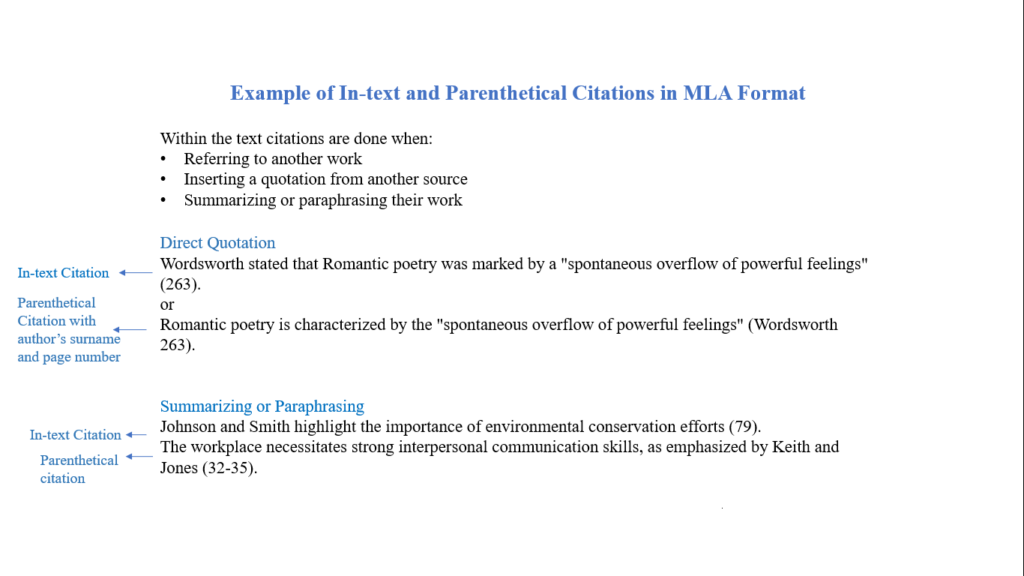
MLA Citation– Direct Quotation, Summarizing, Paraphrasing
When incorporating ideas or information from a source into your writing, there are three primary methods: direct quotation, summarizing, and paraphrasing. Here’s an explanation of each, along with examples of how to implement them in accordance with MLA format:
- Direct Quotation:
When using a direct quotation, enclose the quoted text in double quotation marks. Include the author’s last name and the page number(s) from the source in parentheses immediately after the quotation. Here’s an example:
Atkinson states, “The future belongs to those who believe in the beauty of their dreams” (45).
- Summarizing:
When summarizing information from a source, provide a concise overview of the main points or ideas in your own words. After the summary, include the author’s last name and the page number(s) in parentheses. Here’s an example:
According to Johnson, climate change is a pressing global issue that requires immediate attention (25-27).
- Paraphrasing:
Paraphrasing involves restating information from a source using your own words. After paraphrasing the information, include the author’s last name and the page number(s) in parentheses. Here’s an example:
Thompson’s study highlights that the adoption of renewable energy sources can have a substantial impact on reducing carbon emissions (112).
Make sure you maintain consistency in formatting and ensure that the in-text citations match the corresponding entry on the Works Cited page.
Examples of In-text and Parenthetical Citations
Provided below are examples presented in the form of a direct quotation, summarizing, and paraphrasing:
- Direct quotation (In-text citation): According to Joan, “Climate change is a global challenge” (45).
- Direct quotation (Parenthetical citation): “Climate change is a global challenge” (Joan 45).
- Summarizing (In-text citation): Joan argues that climate change is a significant global problem (45).
- Summarizing (Parenthetical citation): Climate change poses a global challenge, as highlighted by Joan (45).
- Paraphrasing (In-text citation): According to Joan, the issue of climate change presents a formidable obstacle on a global scale (45).
- Paraphrasing (Parenthetical citation): The global challenge of climate change is emphasized by Joan (45).
In all cases, the page number (45) corresponds to the specific location in the source where the information was found. Remember to adjust the page number(s) accordingly based on the source you are using.
Constructing the Works Cited Page
The Works Cited page is a comprehensive list of all the sources you have cited in your paper. It provides readers with the necessary information to locate the sources themselves. Below we have outlined the general format and specific guidelines for constructing an MLA format Works Cited page.
Formatting the Work Cited Page
a. Placement and numbering:
The works cited page should be positioned at the conclusion of your document, following the sequential numbering system used throughout your paper.
b. Heading:
At the top of the page, prominently display the centered heading “Works Cited.”
c. Inclusion of sources:
Include all the sources that you have either paraphrased or directly quoted in your paper on the works cited page.
d. Alphabetical order:
Arrange the sources in alphabetical order, primarily based on the author’s last name. In cases where no author is provided, the entries can be organized alphabetically by title.
e. Hanging indents:
Ensure that the formatting of the entries includes hanging indents. This means that the lines following the first line of each entry are indented.
Specific Guidelines
a. Capitalization:
Capitalize the first letter of the title and subtitle, as well as any important words. Articles, prepositions, and conjunctions should be lowercase unless they appear as the first word or immediately follow a colon.
b. Punctuation:
End each entry with a period and use commas to separate different elements of the citation.
c. Hanging Indentation:
Indent the second and subsequent lines of each citation by 0.5 inches to create a hanging indent, providing a clear visual distinction between entries.
Format of Entries in Works Cited Page
According to the MLA referencing style, the standard structure for an entry on the Works Cited page comprises the subsequent components:
The author’s name(s).
The title of the source, which could be a book, article, website, etc.
The title of the container, if applicable (e.g., a book within an anthology),
Additional contributors, such as editors or translators,
Version information, if applicable,
Number information, if applicable,
The publisher’s name,
The publication date,
The location details, such as page numbers or a URL.
Let us delve into each of the elements separately.
AUTHOR
The author’s last name should be placed first, followed by a comma and the rest of the name as it appears in the work. The author’s name should end with a period.
Example:
Harley, Ted.
TITLE OF SOURCE
The title of the source should immediately follow the author’s name. The formatting of the title depends on the type of source, with books being italicized and individual web pages or articles being placed in quotation marks. If the source is part of a larger container, the title of the container should be italicized and followed by a comma.
Book:
Harley, Ted. The Art of Writing.
Article:
Harley, Ted. “The Impact of Climate Change.”
Website:
Harley, Ted. “How to Start a Business.” Entrepreneur.
TITLE OF CONTAINER
The eighth edition of the MLA handbook introduced the concept of “containers,” which are larger works that hold the source being cited. Containers can be books, television series, websites, or other entities. The title of the container is typically italicized and followed by a comma.
Book:
Harley, Ted. “Chapter One.” The Book of Essays.
Television Series:
“Episode Title.” Game of Thrones, created by David Benioff and D.B. Weiss, HBO.
Website:
Harley, Ted. “Article Title.” The New York Times.
OTHER CONTRIBUTORS
If other contributors have played a significant role in the source, such as editors or translators, their names should be included after the title of the source.
Examples:
Book:
Harley, Ted. The Art of Writing. Edited by Jane Johnson.
Translation:
Woolf, Virginia. Jacob’s Room. Annotated and with an introduction by Vara Neverow
VERSION
If a source has a specific edition or version, it should be included in the citation.
Examples:
Book:
Adam, Chris. The Art of Writing. 2nd edition.
Journal Article:
Harley, Ted. “Research Findings.” Journal of Science, vol. 5, no. 2.
NUMBER
If a source is part of a numbered sequence, such as a multi-volume book or journal with volume and issue numbers, these numbers should be included in the citation.
Examples:
Book:
Harley, Ted. The Art of Writing. Volume 1.
Television Episode:
“Episode Title.” TV Show, season 3, episode 10.
PUBLISHER
The publisher is responsible for producing or distributing the source. If there is more than one publisher relevant to your research, list them separated by a forward slash (/).
Examples:
Klee, Paul. Twittering Machine. Museum of Modern Art
Book:
Harley, Ted. The Art of Writing. ABC Publications.
PUBLICATION DATE
If a source has been published on multiple dates, use the date most relevant to your writing. For sources with more than one date, cite the original publication date.
Examples:
Television Episode:
“Hush.” Buffy the Vampire Slayer, created by Joss Whedon, performance by Sarah Michelle Gellar, season 4, Mutant Enemy, 1999.
Journal Article:
Harley, Ted. “Research Findings.” Journal of Science, vol. 5, no. 2, 2021.
LOCATION
The location includes information such as page numbers for books or articles, URLs for online sources, or the name of a physical location where a work is housed, such as a museum or library.
Book:
Harley, Ted. The Art of Writing. New York: Random House.
Journal Article:
Harley, Ted. “Research Findings.” Journal of Science, vol. 5, no. 2, pp. 20-35.
Website:
Harley, Ted. “Article Title.” www.example.com.
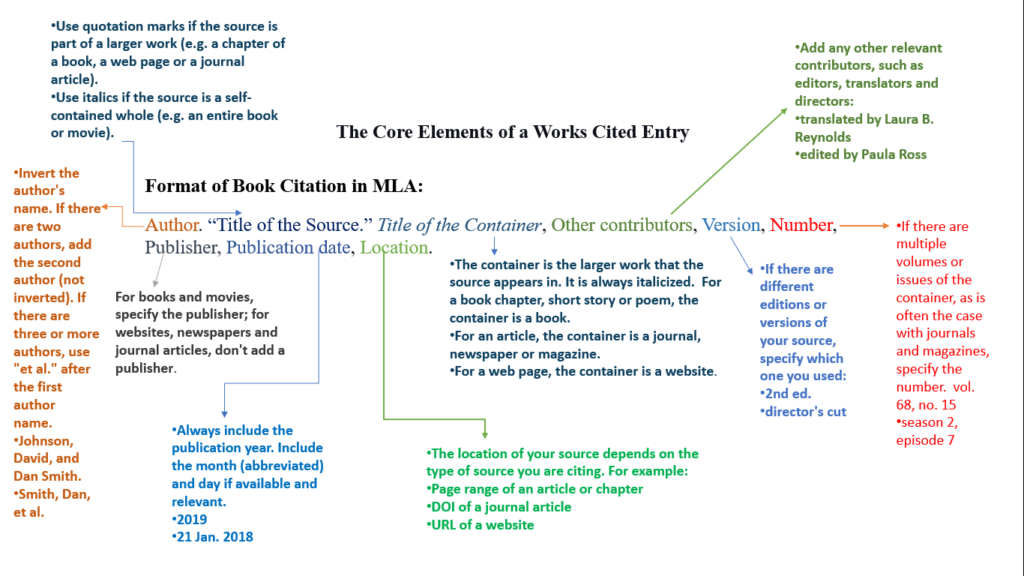
Basic Works Cited Entry Format
Each entry in the Works Cited page begins with the author’s last name, followed by a comma and their first name. The title of the source is then listed in italics, followed by the publication information. Here is the general MLA format citation for various source types:
Book:
Author’s Last Name, First Name. Title of Book. Edition, Publisher, Publication Year.
Example:
Stevenson, Thomas. The Citation Manual for Students: A Quick Guide. 2nd ed., Wiley, 2018.
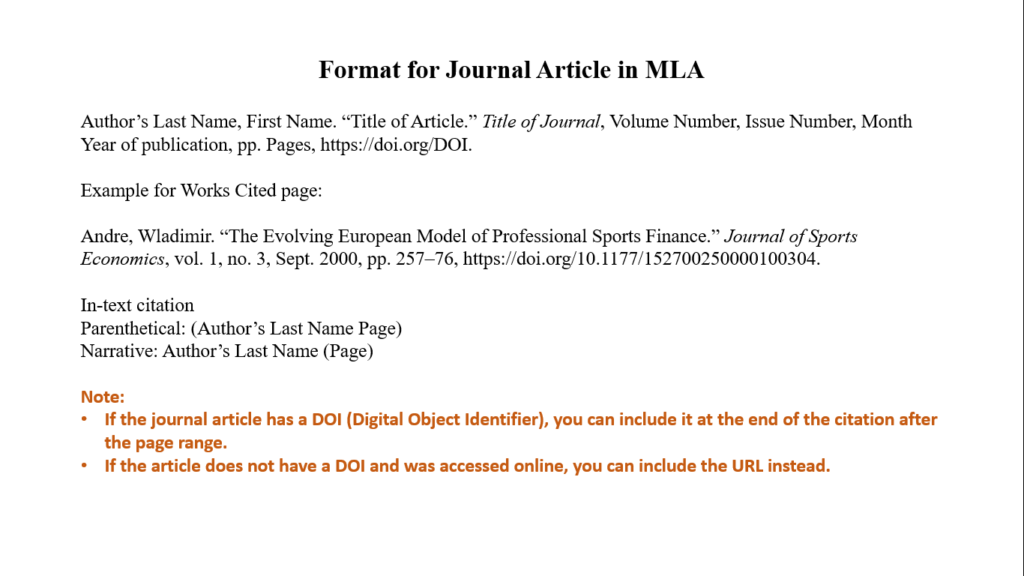
Article in a Journal:
Author’s Last Name, First Name. “Title of Article.” Title of Journal, vol. Volume Number, no. Issue Number, Publication Year, page range.
Example:
Johnson, Sarah. “The Impact of Climate Change on Biodiversity.” Environmental Science Journal, vol. 25, no. 3, 2021, pp. 45-60.
Website:
Author’s Last Name, First Name (if available). “Title of Webpage.” Title of Website, URL (without “http://” or “https://”), Accessed Day Month Year.
Example:
Brown, Emma. “How to Start a Business.” Entrepreneur, www.entrepreneur.com/articles/123456, Accessed 15 June 2023.
Film or Documentary:
Title of Film. Directed by Director’s Name, Performances by Actors’ Names, Production Company, Release Year.
Example:
The Shawshank Redemption. Directed by Frank Darabont, performances by Tim Robbins and Morgan Freeman, Castle Rock Entertainment, 1994.
This guide will be helpful to you in creating an outline research proposal and research papers using MLA Format citation styles for a compelling and well-referenced academic document.
Additional Considerations
Unknown Authors:
If the author’s name is unknown, begin the citation with the title of the source.
Example:
“The Benefits of Meditation.” Mindfulness Magazine, vol. 10, no. 3, 2019, pp. 34-45.
Indirect Sources:
When citing an indirect source, such as a quotation found within another source, include the source in your Works Cited page.
Example Citing an Indirect Source:
Harley, Ted. The Power of Imagination. Random House, 2022. Quoted in Johnson, Emily. “The Role of Creativity in Problem-Solving.” Journal of Innovation, vol. 15, no. 4, 2023, pp. 78-90.
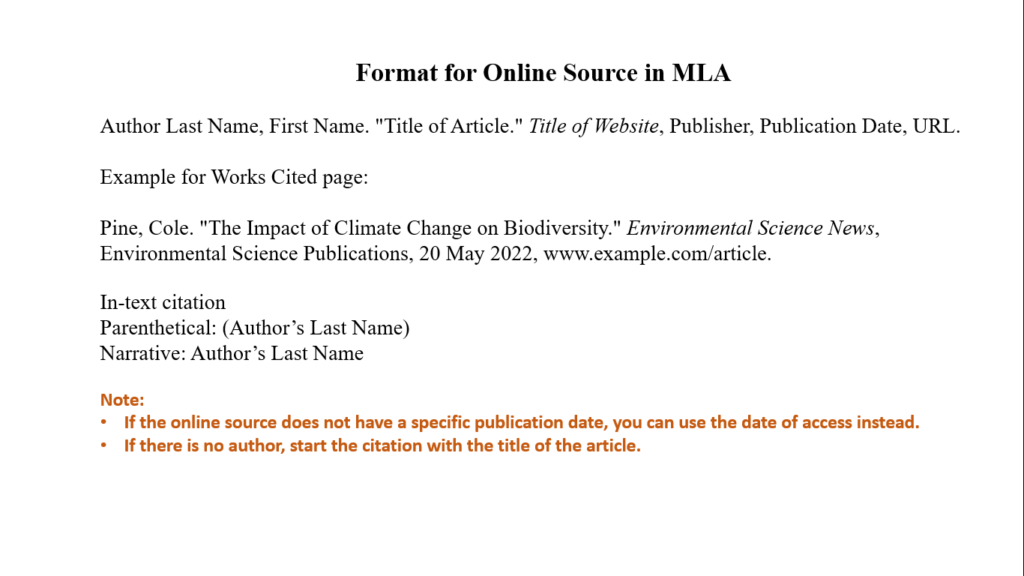
Online Sources:
For online sources, include the URL or DOI (Digital Object Identifier) at the end of the citation. Ensure that the URL is clickable and the DOI is preceded by “https://doi.org/”.
Online Journal Article Example:
Johnson, Emily. “The Impact of Social Media on Mental Health.” Journal of Psychology, vol. 25, no. 2, 2021, pp. 45-60, www.journalofpsychology.com/article/1234.
Also read: What is APA format?
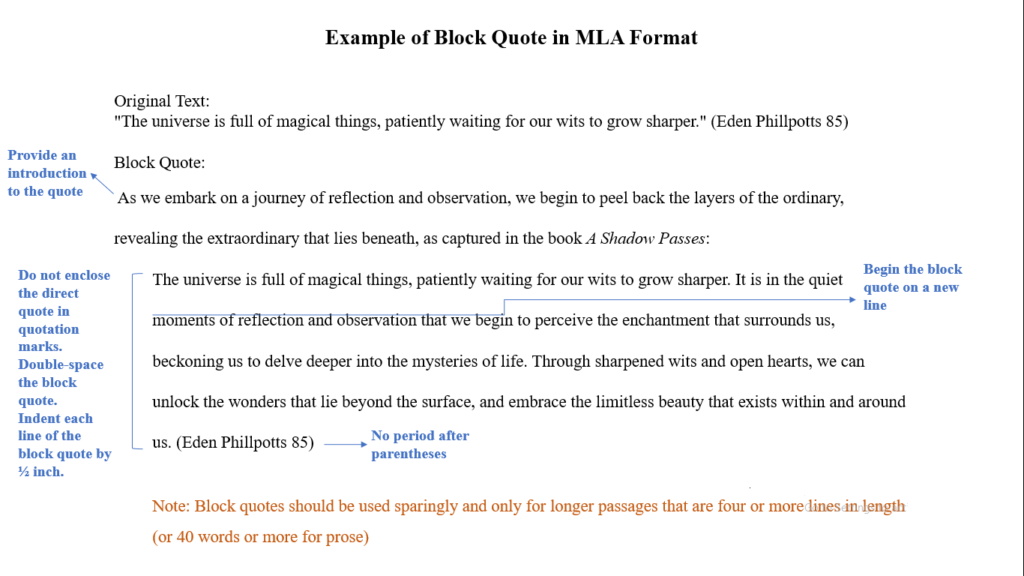
Conclusion
Mastering the MLA format citation style is crucial for any scholar or researcher aiming to produce high-quality academic work. In this comprehensive guide, we have explored the intricacies of in-text citations and the construction of the Works Cited page. By following the guidelines outlined in this article, you will be equipped with the necessary tools to seamlessly incorporate and reference sources in your writing.
Keep in mind that accurate citation not only demonstrates your commitment to academic integrity but also allows readers to further explore the sources that have contributed to your research. Also, know that in case you are having a trouble getting familiar with the formatting styles, worry not, as you can pay essay writing, and our experts will prepare a well-formatted paper according to your required instructions.

